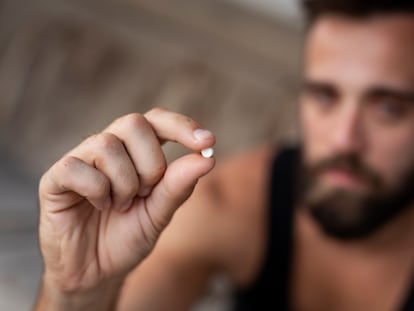Ayahuasca, the next psychedelic drug for mental health
The hallucinogenic beverage from the Amazon could be useful for treating depression or addictions, but scientific studies are still lacking

In the year 2000, Robert Berman and his colleagues from Yale University injected seven depressed people with a small quantity of ketamine. The effects of the drug, first synthesized in 1962 and used as an anesthetic, impressed the researchers. Patients began to improve a day after the injection and continued to do so in the three following days. Almost two decades later, the psychedelic drug, which is also consumed recreationally, was approved in the US in 2019 in the form of esketamine to be consumed with an inhaler.
The drug is associated with clubbing and police seizures, but its approval made it the first new depression treatment in years, and it added to the ongoing psychedelic renaissance. After years of study in research centers and clandestine communities, a variety of molecules that produce altered mental states are close to being used as commercial medications in mental health treatment. MDMA, also popular in nightlife, has been approved in Australia to treat post-traumatic stress disorder, as well as psilocybin for depression. More countries will soon follow its path.
Another substance whose popularity is growing is ayahuasca. The tea, long consumed by indigenous people in the Amazon, is prepared with the liana vine and the leaves of a bush known as chakruna, which contain DMT, a psychedelic compound that causes a hallucinogenic experience. If only the leaves are used, the DMT degrades before reaching the blood, but the active compounds of the liana protect it from stomach enzymes and keep it in the body. It is not unusual, though, for the bitter-tasting beverage to cause vomiting. The effects, along with the intense emotional experiences that it produces, make it unappealing as a form of recreation.
For centuries, peoples of the Americas used ayahuasca to deepen their relationship with nature, their community and themselves. In recent years, more and more people from outside those cultures seek out the tea as a form of escape from modern life. According to observational studies, the study can relieve depression, personality disorders and addictions. Modern science is now attempting to harness ayahuasca’s properties for pharmaceutical purposes.
In a recently published literature review, a group led by Dimitri Daldegan-Bueno, at Brazil’s Campinas State University, reflects on the importance of animal studies to attempt to understand the substance’s effects. They seek to differentiate what effects are due to the ritual around the beverage’s consumption, and they emphasize the importance of placebo studies that compare the effects of those who receive an inert substance and those who take ayahuasca. Though the substance is safe in ceremonial quantities, animal studies demonstrate that it may be toxic in higher doses. For this reason, they dissuade toxicity studies being conducted on pregnant subjects or children, and confirm its potential as an antidepressant or to treat addictions.
Daldegan-Bueno points out that there are already clinical trials with ayahuasca for depression “that have not shown serious side effects.” Decades of studies in communities with a tradition of ayahuasca consumption have not found them either. “This,” he points out, “does not mean that there are no risks in its use. The psychological effects can be very intense [...] and sometimes the person may need support to assimilate the experience. In general, ayahuasca is contraindicated for people with mental disorders related to the psychotic spectrum because it can cause an episode or make it worse,” he warns. In addition, there can be “interactions with some antidepressant medications, so it is advisable that people who take them consult their psychiatrist before taking ayahuasca.”
The researcher affirms that the indigenous communities that take the substance have security measures based on centuries of accumulated knowledge. He notes, though, that the growing popularity of ayahuasca, which can now be taken in weekend retreats in many places thousands of kilometers from the Amazon, requires that new practitioners inform themselves sufficiently.
The psychedelic renaissance will also revive a conflict between plants’ ancestral uses and the uses of modern science. José Carlos Bouso, scientific director of the ICEERS Foundation (International Center for Teaching, Research and Ethnobotanical Services) in Barcelona, dedicated to promoting the safe use of psychoactive plants, says that “ayahuasca ceremonies have been held in Spain for 30 years.” Anthropologists interested in Amazonian medicine “learned to perform rituals there and had shamanic training to reproduce traditional contexts as much as possible,” explains Bouso. “In these community contexts, it has been used, not so much with the biomedical limitations of seeking a cure for a disease, but rather as a form of self-care and managing one’s own health,” he adds.
Bouso was a pioneer in the use of psychedelics in mental health. He faced from prejudices that now seem to be fading. In 2002, when he was 32 years old and a doctoral student at the Autonomous University of Madrid, he started a clinical trial to test MDMA for treatment of post-traumatic stress in victims of sexual assault. After EL PAÍS published an article in 2002 on the project, fears related to the image of public funding of an illegal drug, even for therapeutic purposes, led authorities to halt the study. In recent years, Bouso has carried out observational studies with follow-up of ayahuasca users, both in Spain and Peru, to measure psychological impact and quality of life. “We have seen improvements, especially in depression, mood and quality of life, and also in complex grief and post-traumatic stress,” he says.
In Spain, ayahuasca is in legal limbo. Although it is not specifically prohibited, shamans who offer it have been arrested. There is also a tension between the biomedical and the community model. “There should be a dialogue between these two models, to share knowledge and for everyone to benefit,” Bouso argues. “In the biomedical model, there is knowledge of the theory and how to assess efficiency and effectiveness in the context of clinical trials. But there is no practical knowledge, which we do have in community contexts,” he says. “In my opinion, the ideal would be for there to be regulation and for this dialogue to be encouraged.”
José Morales, a researcher at the Complutense University of Madrid, is on the more scientific side of the psychedelic revolution, but he also considers the experience of community use to be important. “We have information from thousands of people who have consumed ayahuasca and we have no reported deaths when it is used alone. It’s different when it is mixed with sapo bufo, cocaine or other substances,” affirms Morales, who says that “DMT does not create addiction.” His laboratory researches the use of the substance within the Western scientific and pharmaceutical model, studying how to transfer the use of DMT, injected, inhaled or drunk, to the clinic, “like any other drug,” says Morales.
People who take ayahuasca in shamanic contexts seek a mystical experience in which hallucinations can occur, but the biomedical approach has other goals. “We have seen that the therapeutic effect, to treat depression or addictions, can be achieved from microdoses without these hallucinogenic effects, because we have observed that this therapeutic effect is produced by a different receptor,” explains Morales. The research will try to develop more standardized treatments in which the exact amount of the drug is controlled and the treatment can be evaluated with some objectivity.
These types of drugs are getting closer. A few weeks ago, the Canadian company Filament Health announced that it is seeking approval from the FDA, the US medical agency, to begin trials with the first ayahuasca pill.
At the Research Institute of the Hospital de Sant Pau, in Barcelona, Joaquim Soler has studied the potential of ayahuasca to improve the effects of meditation. “We have seen that after taking a shot, the capacity for acceptance and self-love improves and the tendency to judge oneself decreases. It is like the effect that is achieved with mindfulness, but without so much training time,” he explains. “It can be useful for treating people with childhood trauma or sexual abuse, because it allows them to evoke autobiographical memories with a very high degree of acceptance. It is a reprocessing similar to prolonged psychotherapy,” he continues.
As in the case of other psychedelic drugs, for the experience to be useful, it will require monitoring by trained professionals, which makes this type of therapy more expensive and difficult. In principle, it cannot be used as an antidepressant pill that the patient takes at home under minimal medical supervision. “You have to apply it in the correct context, because a bad experience can lead you to psychiatry for post-traumatic stress,” warns Soler, who believes that it is necessary to study the mechanisms that make it work.
With the opening towards the therapeutic uses of ayahuasca, there has also been a boom in its use in community ceremonies that are not always organized by people with adequate training. Daldegan-Bueno recalls that “a recent study identified contaminants such as drugs and other psychedelic substances in ayahuasca samples throughout Europe.” Taking aspects like this into account “is essential, both for people who seek and offer ayahuasca,” he says. The harmony between traditional knowledge, the scientific method and the regulation of the use of ayahuasca can help to avoid the risks of uncritical belief in exotic substances with magical qualities to solve life’s problems, as well as the racism and conservatism that has delayed the use of substances whose potential is increasingly clear.
Sign up for our weekly newsletter to get more English-language news coverage from EL PAÍS USA Edition
Tu suscripción se está usando en otro dispositivo
¿Quieres añadir otro usuario a tu suscripción?
Si continúas leyendo en este dispositivo, no se podrá leer en el otro.
FlechaTu suscripción se está usando en otro dispositivo y solo puedes acceder a EL PAÍS desde un dispositivo a la vez.
Si quieres compartir tu cuenta, cambia tu suscripción a la modalidad Premium, así podrás añadir otro usuario. Cada uno accederá con su propia cuenta de email, lo que os permitirá personalizar vuestra experiencia en EL PAÍS.
¿Tienes una suscripción de empresa? Accede aquí para contratar más cuentas.
En el caso de no saber quién está usando tu cuenta, te recomendamos cambiar tu contraseña aquí.
Si decides continuar compartiendo tu cuenta, este mensaje se mostrará en tu dispositivo y en el de la otra persona que está usando tu cuenta de forma indefinida, afectando a tu experiencia de lectura. Puedes consultar aquí los términos y condiciones de la suscripción digital.
More information
Archived In
Últimas noticias
Maduro pleads not guilty before the federal court in New York: ‘I am still the president of Venezuela’
A new test can detect Alzheimer’s from a finger prick
UN team enters Sudanese city of El Fasher after paramilitary massacre: ‘It’s like a ghost town’
A recipe for resistance: Indigenous peoples politicize their struggles from the kitchen
Most viewed
- Gilles Lipovetsky: ‘If you want to live better and fall in love, take Prozac, don’t look to philosophy’
- Alain Aspect, Nobel laureate in physics: ‘Einstein was so smart that he would have had to recognize quantum entanglement’
- Maduro’s downfall puts China’s relationship with Venezuela to the test
- Why oil has been at the center of Venezuela-US conflicts for decades
- Alvin Hellerstein, a 92-year-old judge appointed by Bill Clinton, to preside over Maduro’s trial in New York











































